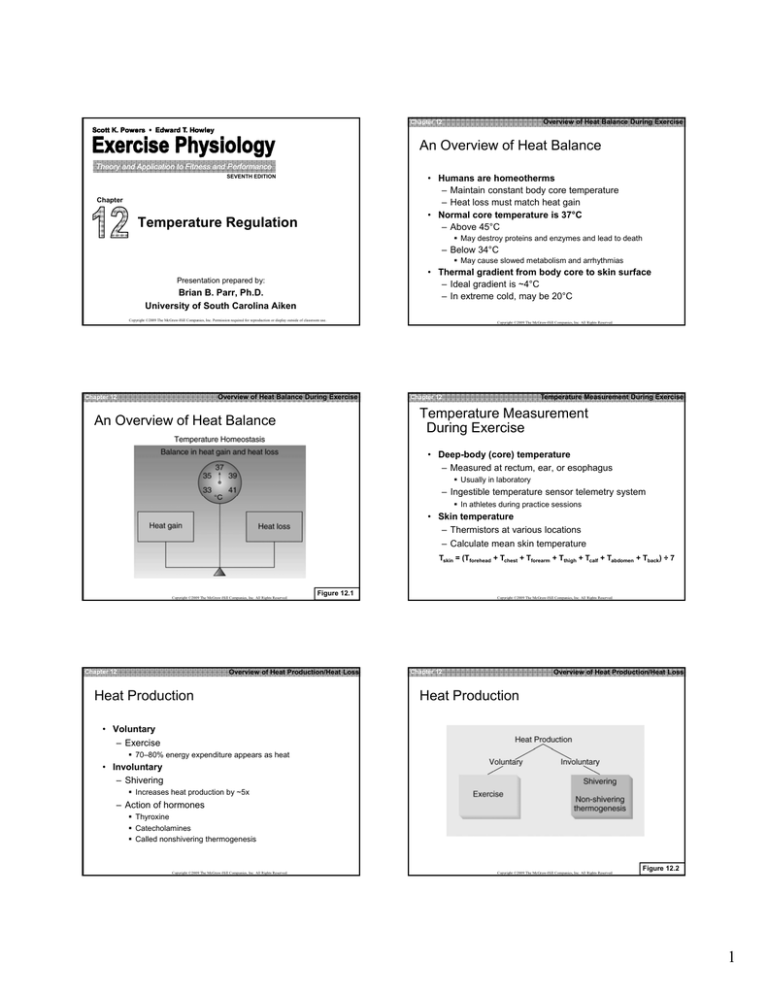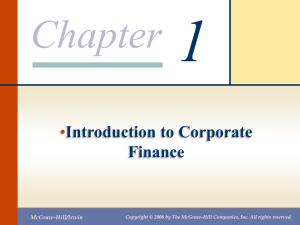
Overview of Heat Balance During Exercise
Chapter 12
Scott K. Powers • Edward T. Howley
An Overview of Heat Balance
Theory and Application to Fitness and Performance
• Humans are homeotherms
– Maintain constant body core temperature
– Heat loss must match heat gain
• Normal core temperature is 37°C
– Above 45°C
SEVENTH EDITION
Chapter
Temperature Regulation
May destroy proteins and enzymes and lead to death
– Below 34°C
May cause slowed metabolism and arrhythmias
• Thermal gradient from body core to skin surface
– Ideal gradient is ~4°C
– In extreme cold, may be 20°C
Presentation prepared by:
Brian B. Parr, Ph.D.
University of South Carolina Aiken
Copyright ©2009 The McGraw-Hill Companies, Inc. Permission required for reproduction or display outside of classroom use.
Overview of Heat Balance During Exercise
Chapter 12
Copyright ©2009 The McGraw-Hill Companies, Inc. All Rights Reserved.
Temperature Measurement During Exercise
Chapter 12
Temperature Measurement
During Exercise
An Overview of Heat Balance
• Deep-body (core) temperature
– Measured at rectum, ear, or esophagus
Usually in laboratory
– Ingestible
g
temperature
p
sensor telemetry
y system
y
In athletes during practice sessions
• Skin temperature
– Thermistors at various locations
– Calculate mean skin temperature
Tskin = (Tforehead + Tchest + Tforearm + Tthigh + Tcalf + Tabdomen + Tback) ÷ 7
Copyright ©2009 The McGraw-Hill Companies, Inc. All Rights Reserved.
Figure 12.1
Overview of Heat Production/Heat Loss
Chapter 12
Heat Production
Copyright ©2009 The McGraw-Hill Companies, Inc. All Rights Reserved.
Overview of Heat Production/Heat Loss
Chapter 12
Heat Production
• Voluntary
– Exercise
70–80% energy expenditure appears as heat
• Involuntary
y
– Shivering
Increases heat production by ~5x
– Action of hormones
Thyroxine
Catecholamines
Called nonshivering thermogenesis
Copyright ©2009 The McGraw-Hill Companies, Inc. All Rights Reserved.
Copyright ©2009 The McGraw-Hill Companies, Inc. All Rights Reserved.
Figure 12.2
1
Chapter 12
Overview of Heat Production/Heat Loss
Heat Loss
Overview of Heat Production/Heat Loss
Chapter 12
Heat Loss
• Radiation
– Transfer of heat via infrared rays
– 60% heat loss at rest
– Can be a method of heat gain
• Conduction
– Heat loss due to contact with another surface
• Convection
– Heat transferred to air or water
– Example: a fan pushing air past skin
• Evaporation
– Heat from skin converts water (sweat) to water
vapor
Requires vapor pressure gradient between skin and air
– Evaporation rate depends on:
Temperature and relative humidity
Convective currents around the body
Amount of skin surface exposed
– Body loses 0.58 kcal heat/L sweat evaporated
1 L sweat results in heat loss of 580 kcal
– 25% heat loss at rest
Most important means of heat loss during exercise
Copyright ©2009 The McGraw-Hill Companies, Inc. All Rights Reserved.
Chapter 12
Copyright ©2009 The McGraw-Hill Companies, Inc. All Rights Reserved.
Overview of Heat Production/Heat Loss
Temperature, Relative Humidity, and
Vapor Pressure
Overview of Heat Production/Heat Loss
Chapter 12
A Closer Look 12.1
Calculation of Heat Loss via Evaporation
• Evaporation of 1,000 ml of sweat results in 580 kcal
of heat loss
• Example:
– 20 min cycling
y g at VO2 = 2.0 L•min–1 ((10 kcal•min–1)
20% efficient = 80% energy lost as heat
– Total energy expenditure
20 min x 10 kcal/min = 200 kcal
– Total heat produced
200 kcal x 0.80 = 160 kcal
– Evaporation to prevent heat gain
160 kcal ÷ 580 kcal/L = 0.276 L
Copyright ©2009 The McGraw-Hill Companies, Inc. All Rights Reserved.
Chapter 12
Copyright ©2009 The McGraw-Hill Companies, Inc. All Rights Reserved.
Overview of Heat Production/Heat Loss
Heat Exchange Mechanisms
During Exercise
Chapter 12
Overview of Heat Production/Heat Loss
Heat Storage in the Body
During Exercise
• Heat produced that is not lost is stored in body
tissues
– Will raise body temperature
Body heat gain during exercise = heat produced – heat loss
• Amount of heat required to raise body temperature
– Specific heat of human body is 0.83 kcal/kg
Heat required to raise body temp 1°C = specific heat x body mass
Copyright ©2009 The McGraw-Hill Companies, Inc. All Rights Reserved.
Figure 12.3
Copyright ©2009 The McGraw-Hill Companies, Inc. All Rights Reserved.
2
Overview of Heat Production/Heat Loss
Chapter 12
Overview of Heat Production/Heat Loss
Chapter 12
A Closer Look 12.2
Calculation of Body Temperature
Increase During Exercise
In Summary
• 60-kg runner, 40 min at VO2 = 3.0 L•min–1 (15 kcal•min–1)
– 20% efficient, can lose 60% of heat produced
– Pre-exercise body temperature = 37°C
• Total energy expenditure
40 min x 15 kcal/min = 600 kcal
• Total heat produced
600 kcal x 0.80 = 480 kcal
• Total heat stored
480 kcal x 0.40 = 192 kcal
• Amount of heat storage to increase body temperature by 1°C
0.83 kcal/kg x 60 kg = 49.8 kcal
• Increase in body temperature during exercise
192 kcal/49.8 kcal/°C = 3.86°C
• Post-exercise body temperature
37°C + 3.86°C = 40.86°C
The rate of evaporation from the skin is dependent upon
three factors: (1) temperature and relative humidity, (2)
convective currents around the body, and (3) the amount
of skin exposed to the environment.
Body heat storage is the difference between heat
production and heat loss.
The amount of heat required to elevate body
temperature by 1°C is termed the specific heat of the
body.
Copyright ©2009 The McGraw-Hill Companies, Inc. All Rights Reserved.
Copyright ©2009 The McGraw-Hill Companies, Inc. All Rights Reserved.
The Body’s Thermostat—Hypothalamus
Chapter 12
The Body’s Thermostat—Hypothalamus
The Body’s Thermostat—Hypothalamus
Chapter 12
Physiological Responses to “Heat Load”
• Anterior hypothalamus
– Responds to increased core temperature
– Commencement of sweating
Increased evaporative heat loss
– Increased skin blood flow
Allows increased heat loss
• Posterior hypothalamus
– Responds to decreased core temperature
– Shivering and increased norepinephrine release
Increased heat production
– Decreased skin blood flow
Decreased heat loss
Copyright ©2009 The McGraw-Hill Companies, Inc. All Rights Reserved.
Chapter 12
Copyright ©2009 The McGraw-Hill Companies, Inc. All Rights Reserved.
The Body’s Thermostat—Hypothalamus
Physiological Responses to Cold Stress
Figure 12.4
Thermal Events During Exercise
Chapter 12
Thermal Events During Exercise
• As exercise intensity increases:
– Heat production increases
– Linear increase in body temperature
Core temperature proportional to active muscle mass
– Higher net heat loss
Lower convective and radiant heat loss
Higher evaporative heat loss
• As ambient temperature increases:
– Heat production remains constant
– Lower convective and radiant heat loss
– Higher evaporative heat loss
Copyright ©2009 The McGraw-Hill Companies, Inc. All Rights Reserved.
Figure 12.5
Copyright ©2009 The McGraw-Hill Companies, Inc. All Rights Reserved.
3
Chapter 12
Thermal Events During Exercise
Changes in Metabolic Energy Production
and Heat Loss During Exercise
Copyright ©2009 The McGraw-Hill Companies, Inc. All Rights Reserved.
Chapter 12
Thermal Events During Exercise
Chapter 12
Body Temperature During Arm
and Leg Exercise
Figure 12.6
Thermal Events During Exercise
Heat Exchange During Exercise at
Different Environmental Temperatures
Copyright ©2009 The McGraw-Hill Companies, Inc. All Rights Reserved.
Figure 12.7
Thermal Events During Exercise
Chapter 12
Thermal Events During Exercise
• Increase in body temperature is directly related to
exercise intensity
– Body heat load increases with intensity
• Mechanisms of heat loss during exercise
– Evaporation
Most important means of heat loss
– Convection
Small contribution
– Radiation
Small role in total heat loss
Copyright ©2009 The McGraw-Hill Companies, Inc. All Rights Reserved.
Chapter 12
Figure 12.8
Thermal Events During Exercise
Heat Exchange At Rest and
During Exercise
Copyright ©2009 The McGraw-Hill Companies, Inc. All Rights Reserved.
Copyright ©2009 The McGraw-Hill Companies, Inc. All Rights Reserved.
Chapter 12
Heat Index—A Measure of How Hot It Feels
Relationship of Relative Humidity (%),
Temperature, and Heat Index
Figure 12.9
Copyright ©2009 The McGraw-Hill Companies, Inc. All Rights Reserved.
Figure 12.10
4
Exercise in the Heat
Chapter 12
Core Temperature and Sweat Rate
During Exercise in a Hot/Humid
Environment
Exercise in the Heat
• Inability to lose heat
– Higher core temperature
– Risk of hyperthermia and heat injury
• Higher sweat rate
– May
M b
be as hi
high
h as 4
4–5
5 L/h
L/hour
– Risk of dehydration
Copyright ©2009 The McGraw-Hill Companies, Inc. All Rights Reserved.
Figure 12.11
Copyright ©2009 The McGraw-Hill Companies, Inc. All Rights Reserved.
Exercise in the Heat
Chapter 12
Exercise in the Heat
Chapter 12
Clinical Applications 12.1
Exercise in the Heat
Chapter 12
The Winning Edge 12.1
Exercise-Related Heat Injuries
Can Be Prevented
Prevention of Dehydration During
Exercise
• Guidelines
– Exercise during the coolest part of the day
– Minimize exercise intensity and duration on
hot/humid days
– Expose
E
a maximal
i l surface
f
area off skin
ki ffor
evaporation
– Provide frequent rests/cool-down breaks with
equipment removal
– Avoid dehydration with frequent water breaks
– Rest/cool-down breaks should be in the shade and
offer circulating, cool air
• Dehydration of 1–2% body weight can impair
performance
• Guidelines
– Hydrate prior to performance
400–800
400 800 mll fl
fluid
id within
ithi th
three h
hours prior
i tto exercise
i
– Consume 150–300 ml fluid every 15–20 min
Volume adjusted based on environmental conditions
– Ensure adequate rehydration
Consume equivalent of 150% weight loss
1 kg body weight = 1.5 L fluid replacement
– Monitor urine color
• Sports drinks are superior to water for rehydration
Copyright ©2009 The McGraw-Hill Companies, Inc. All Rights Reserved.
Copyright ©2009 The McGraw-Hill Companies, Inc. All Rights Reserved.
Exercise in the Heat
Chapter 12
Exercise Performance in a
Hot Environment
• Can result in muscle fatigue and impaired
performance
– Reduced mental drive for motor performance
– Reduced muscle blood flow
– Accelerated g
glycogen
y g metabolism
– Increased lactic acid production
– Increased free radical production
Exercise in the Heat
Chapter 12
Research Focus 12.1
Exercise in the Heat Accelerates
Muscle Fatigue
• Rapid onset of muscle fatigue in hot/humid
environments
• Heat-related muscle fatigue due to:
– High brain temperature reduces neuromuscular
drive
Reduction in motor unit recruitment
– Accelerated muscle glycogen metabolism and
hypoglycemia
Controversial
– Increased free radical production
Damage to muscle contractile protein
Copyright ©2009 The McGraw-Hill Companies, Inc. All Rights Reserved.
Copyright ©2009 The McGraw-Hill Companies, Inc. All Rights Reserved.
5
Exercise in the Heat
Chapter 12
Gender and Age Differences in
Thermoregulation
Heat Acclimatization
• Women less heat tolerant than men
– Lower sweat rates
– Higher percent body fat
• Age itself does not limit ability to thermoregulate
– Decreased thermotolerance with age due to:
Deconditioning with age
Lack of heat acclimatization
• Requires exercise in hot environment
• Adaptations occur within 7–14 days
– Increased plasma volume
– Earlier onset of sweating
– Higher sweat rate
– Reduced sodium chloride loss in sweat
– Reduced skin blood flow
– Increased cellular heat shock proteins
• Acclimatization lost within a few days of inactivity
Copyright ©2009 The McGraw-Hill Companies, Inc. All Rights Reserved.
Copyright ©2009 The McGraw-Hill Companies, Inc. All Rights Reserved.
Exercise in the Heat
Chapter 12
Exercise in the Heat
Chapter 12
Research Focus 12.2
Exercise in the Heat
Chapter 12
Research Focus 12.3
Can Sweat Clothing Promote Heat
Acclimatization?
• Training in cool climates using sweat clothing
– Alternative to traveling to warmer climate to
acclimatize
– Raises body temperature
• Does
D
iit work?
k?
– Yes, but not as effective as training in hot/humid
environment
• Increases sweat rate and body water loss
– Not effective for fat loss
• Risk of hyperthermia and heat injury
Copyright ©2009 The McGraw-Hill Companies, Inc. All Rights Reserved.
Heat Acclimatization and Heat Shock
Proteins
• Heat acclimatization reduces the risk of heat injury
– In response to exposure of heat stress
• Related to synthesis of heat shock proteins
– Protect cells from thermal injury
– Stabilizing and refolding damaged proteins
Copyright ©2009 The McGraw-Hill Companies, Inc. All Rights Reserved.
Exercise in the Heat
Chapter 12
Primary Adaptations of Heat
Acclimatization
Copyright ©2009 The McGraw-Hill Companies, Inc. All Rights Reserved.
6





